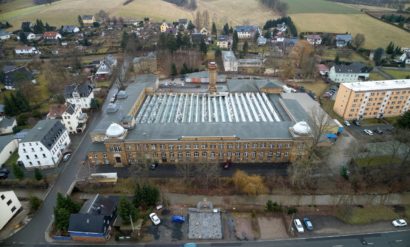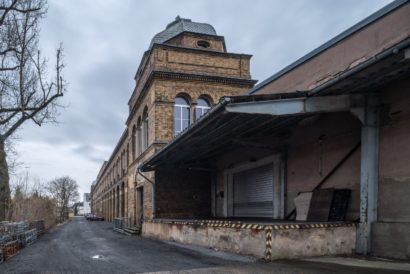Mülsen St. Micheln Subcamp
January 27, 1944 – April 13, 1945
![]()
Aerial view of the former textile factory in Mülsen St. Micheln, 2018 (Flossenbürg Concentration Camp Memorial / Photo: Rainer Viertlböck)
![]()
Former textile factory in Mülsen St. Micheln, 2018 (Flossenbürg Concentration Camp Memorial / Photo: Rainer Viertlböck)
-
Prisoners
Averaging 500, in total over 1,100 men. Over 450 prisoners from the Soviet Union, about 350 Polish, 70 each French and Italian, along with German, Czech and prisoners from 12 other countries.
-
Forced labor and quarters
Production of engines for the Me 109 fighter plane for the Erla Maschinenfabrik GmbH. Many of the prisoners, previously in subcamps of the Buchenwald concentration camp, had already been forced to work for Erla in the area of Leipzig.
-
The prisoners were quartered in the dark, confined, and stuffy basement of the disused textile factory. Three barracks were built following a fire on May 1, 1944.
-
Guards
A sergeant of the air force, two non-commissioned officers and 20 male guards. Detail leader Erich von Berg was replaced by Georg Degner following the catastrophic fire on May 1, 1944.
-
Death toll
Almost a third of the prisoners died in Mülsen. 198 lost their lives on the night of May 1-2, 1944 when Soviet prisoners set fire to their straw mattresses in protest against their poor rations.
-
The SS locked the prisoners in and shot anyone trying to escape the fire. The guard squads prevented the fire brigade from putting out the fire. Scores of seriously injured prisoners were transported to Flossenbürg, 53 were executed there. Prisoners died of typhus in March 1945.
-
Disbanding of the camp / end of the war
The subcamp was evacuated on April 13, 1945. The prisoners were sent by foot and by train to Leitmeritz, where they were liberated by Soviet troops.
-
Commemoration
In 1946, a memorial stone was erected for 51 reburied dead bodies. Across from the textile factory there is a bigger monument with a number of single commemorative plaques.

